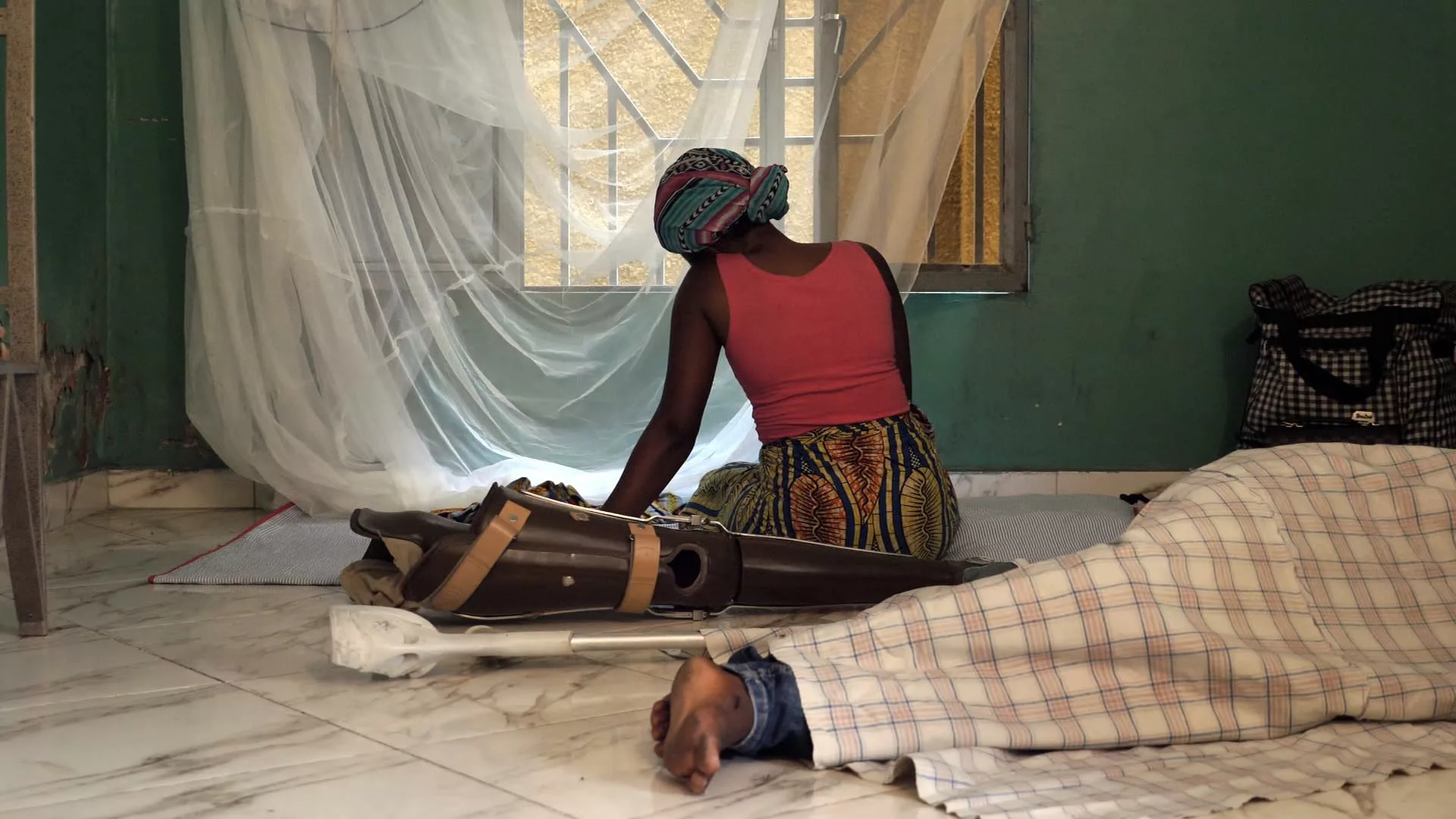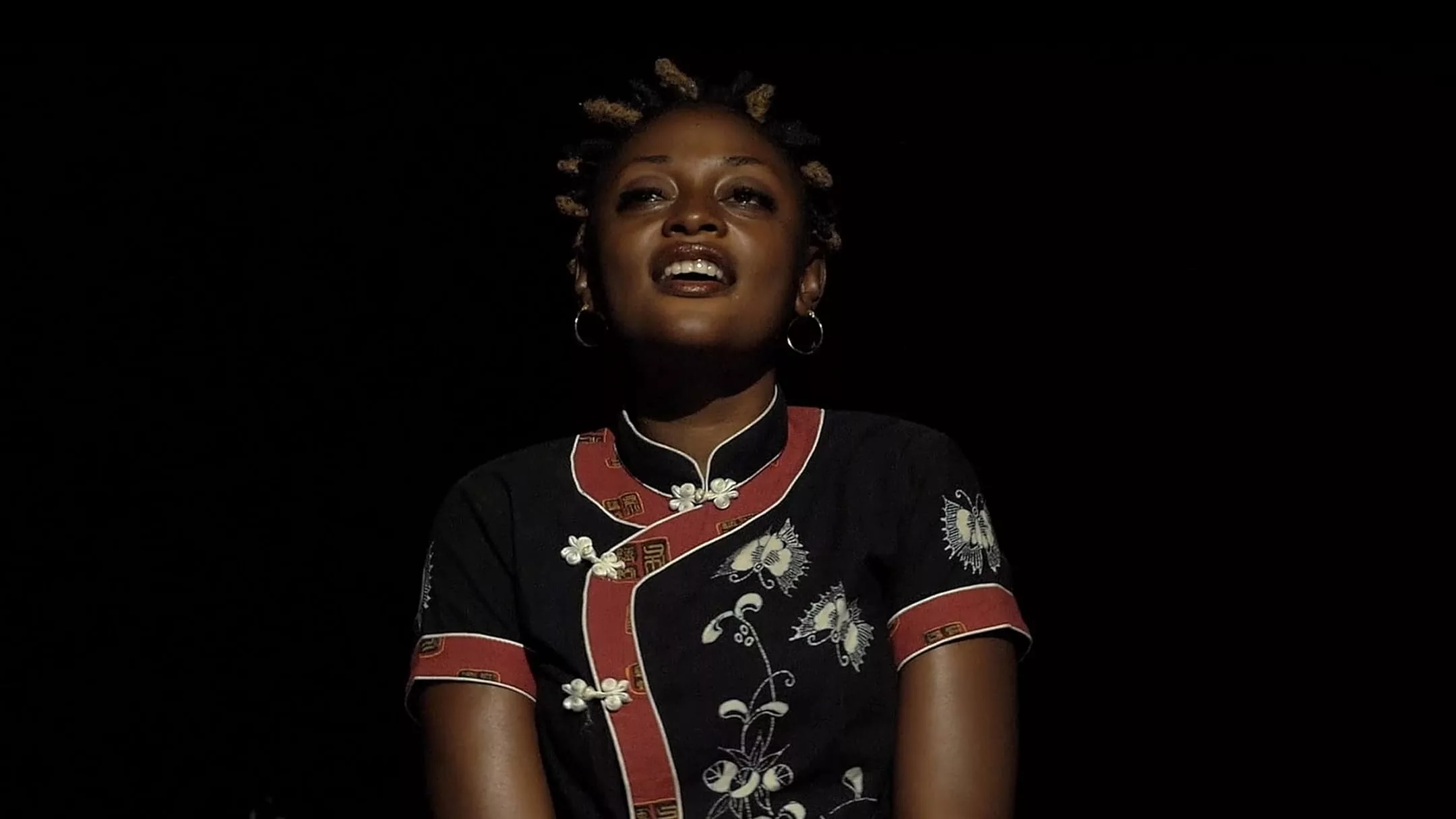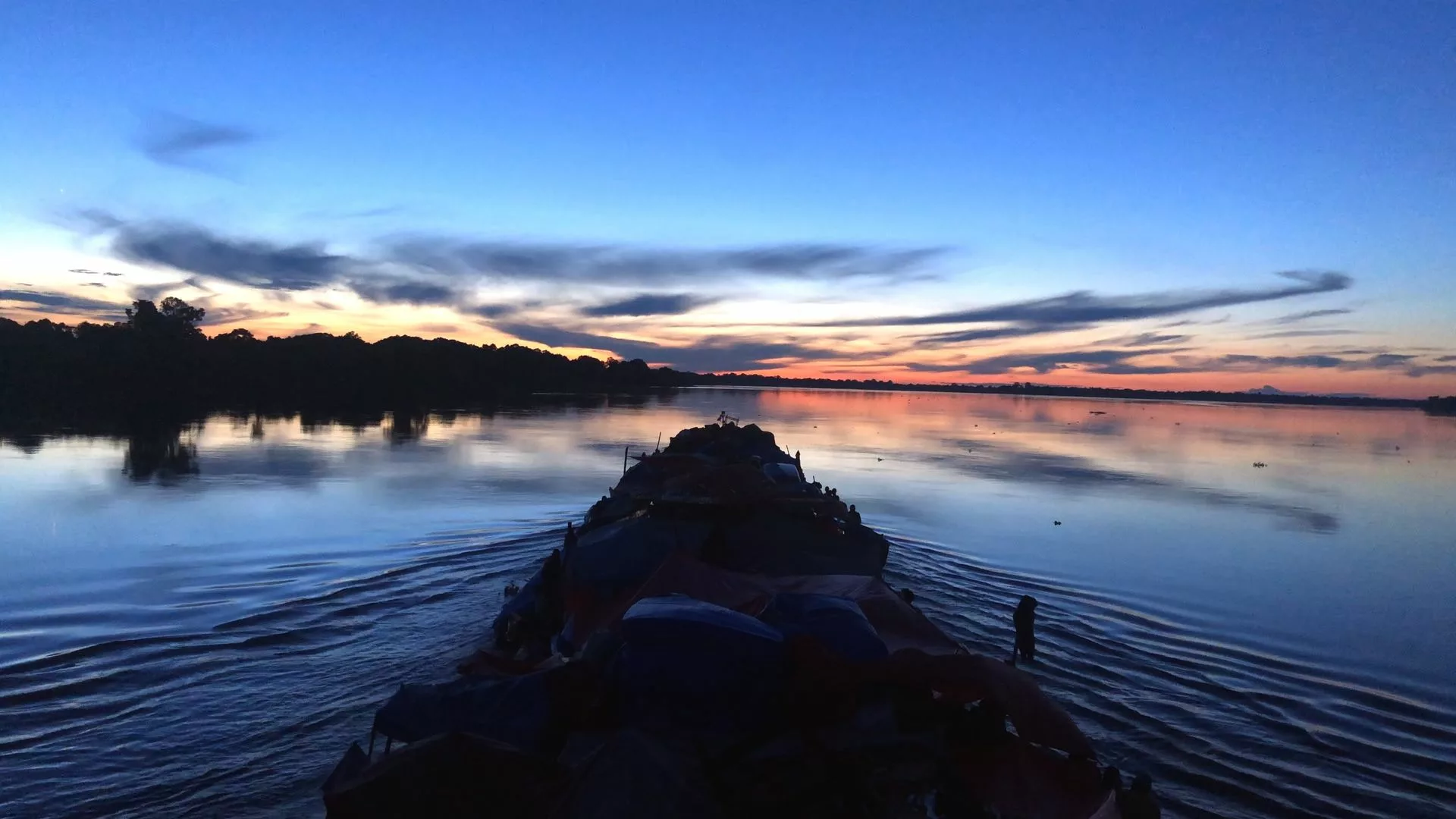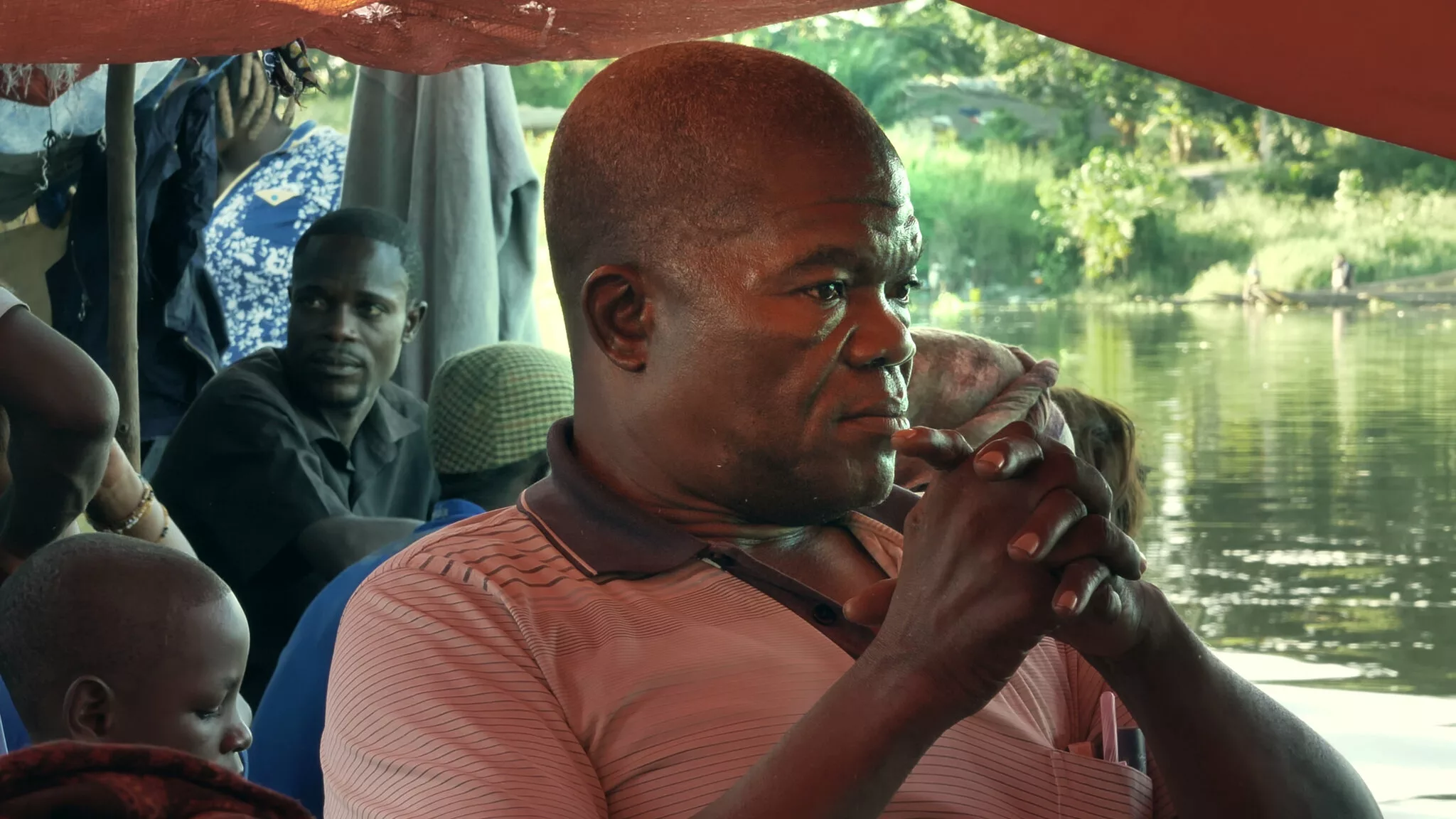The boat winds its way slowly down the river, its passengers cramped but resolute. A decades-long fight has brought them here, carrying scars both physical and invisible. In 2000, war tore through Kisangani in the Democratic Republic of the Congo. Over six bloody days, thousands lost their lives or suffered devastating injuries that would haunt them for the rest of their days.
Now, in 2018, a group decides the time for waiting is over. Frustrated by empty promises and closed doors from their government, over a hundred survivors embark on a harrowing 1,700-kilometer journey by river to Kinshasa, the capital city. There they will demand the compensation owed for their suffering—one billion dollars for the victims of the infamous Six-Day War. Documentarian Dieudo Hamadi boards alongside them, his camera capturing their raw determination in the face of immense hardship.
Through scenes of both drama and documentary, Hamadi shines a light on these survivors’ perseverance with quiet empathy. Their boat trip brings shared songs and clashes of will, while storms threaten to overwhelm them. Yet a spirit of solidarity prevails as they near their destination, still seeking the justice long denied. Downstream to Kinshasa offers a glimpse into remarkable resilience, reminding us that some wounds can only begin to heal when a voice is finally heard.
Expressing Resilience Through Film
Dieudo Hamadi places himself directly within the story he aims to tell. By opting for a first-person documentary style and grippy handheld camerawork, he experiences alongside the survivors every challenge of their odyssey down the Congo River. From cramped quarters on the overloaded boat to torrential downpours that threaten to capsize them, Hamadi’s lens puts us in the midst of the action.
At the same time, aerial drone shots provide sweeping views that underscore the immense scale of both journey and cause. We see the tiny vessel navigating massive waterways, representing the David versus Goliath nature of the survivors’ struggle. Yet the film avoids relying on sensationalism to dramatize their plight.
Up close, amid the swirling faces, Hamadi forges intimate access without an ounce of gratuitousness. Even moments of raw emotion feel like an honest understanding between documentarian and subject. Through challenging conditions like storms that have viewers holding their breath, he maintains a careful balance. Dignity is reserved for people who have endured tremendous loss of life and limb.
With a light directorial touch, Hamadi brings forth a hard-won triumph from hardship. Expressing resilience through film draws us into their world while keeping their humanity central. Both voyagers and those who push relentlessly forward receive fervent portraits.
Expressing Experience Through Performance
Filmmaker Dieudo Hamadi makes powerful use of theatrical elements to amplify the survivors’ voices. Through monologues, music, and a semifictional play, their raw emotions and memories are laid bare.
A standout is Sola, whose performances offer a window into her personal journey. Her monologue recounting the day she lost her legs during the war grabs your full attention. Her rawness and vulnerability in those moments will likely stick with viewers long after.
Yet Sola also shares a more hopeful side performed later—her wedding day. Even after so much tragedy, her ability to reminisce about happiness lifts the soul. The contrast between the two roles displays the breadth of Sola’s resilience and spirit in overcoming immense challenges.
Watching these scenes, it’s clear how cathartic and empowering the creative process proved for all involved. By incorporating their theatrical productions, Hamadi grants his subjects ownership of their stories. They have a direct hand in articulating what the war stole and what drives their fight for justice.
The layer of fictionalization also provides deeper context that taps into universal human experiences beyond just recounting facts. It’s an inventive, deeply impactful approach that amplifies the survivors’ plight on an emotional level many will relate to.
Expressing Experience Through Performance spotlights the power of shared healing and how art can keep memory alive until wrongs are righted. The humanity at its core stays with you long after viewing.
Shining Light on Shared Experience and Strength of Spirit
Among the most dramatic moments on the survivors’ journey are realizations about their treatment at home. As conditions on the boat grow difficult, their conversation turns to a lack of support from loved ones.
It’s heartbreaking to hear they suffered neglect, disrespect, and even pressure toward suicide. Yet somehow, these brave individuals maintained hope. They understood their inherent worth and refused to let pain dim their drive to be heard.
Despite conflicts inevitable when crowds are crammed together, a uniting purpose in seeking justice from their government remained strong. Personal differences took a backseat to solidarity in a far greater cause. Their resolve shone through, keeping spirits lifted.
Dieudo Hamadi’s film stands as a testament to the indomitable human spirit. Even in the Congo’s darkest of days, art and creativity provided light. Through performance, the survivors externalized trauma and found means of catharsis.
Their 1,700-kilometer voyage itself was an incredible act of resilience. But it’s the spirit driving that journey—compassion for others, fierce advocacy for dignity—that makes their story so inspiring. No matter the challenges faced internally or externally, their fight for fairness pressed on.
Downstream to Kinshasa captures universal human truths about perseverance, community, and the power of shared experience. It spotlights the triumph of the soul where many might see only suffering. In doing so, it brings hope that understanding can grow even in the world’s most troubled places.
Facing the Elements on the Mighty Congo
Just imagine squeezing over 100 people onto a couple simple wooden boats lashed together. That was the scene as survivors from Kisangani embarked on their massive river journey. With barely room to move, tensions were sure to rise.
Dieudo Hamadi captures it all: cramped passengers bantering, cooking, and catching rare moments of sleep. But when heavy rain pours, all you can do is cling desperately to flapping tarps. Little protection from the raging storm in the Congo’s waters.
Still, community bonds formed despite the close quarters. We see moments of song and dance lifting spirits. But arguments erupted too, like when one man loudly lamented the poor quality of food. Disagreements are natural under such conditions.
The director doesn’t shy away from the difficulties. His powerful camerawork, placed right in the swarm of people, feels real, not staged. As strong winds batter the boat, his lens gets sprayed, just like the passengers bracing face-first into the torrent.
Things take a dangerous turn when the waters rise dramatically. Screams ring out as the boat takes on water through a sizable hole. Passengers scramble to bail, fearing for their lives. We wonder if they can make repairs before being swamped entirely.
What amazing perseverance and courage for these survivors to face such huge challenges on their odyssey downriver! Risking all against the mighty force of nature, they refused to give up their pursuit of justice even in their darkest hour. Their indomitable spirit shines through.
Facing Setbacks in the “Light of Liberty”
After weathering perilous waters, the survivors from Kisangani finally reach Kinshasa, where battles for justice will continue on dry land. We’ve seen this group’s spirit carry them downriver despite all obstacles. But now, in the “Light of Liberty,” as Congo’s capital is known, their reception brings new challenges.
The denial of access to meet with government officials crushes hopes for quick solutions. Instead, the survivors peacefully protested with colorful banners spelling out demands. But torrential rains leave them huddled despairingly in the downpour. Still, they refuse to back down, resolved to see this through.
Dieudo Hamadi’s camera captures it all, holding leaders accountable. While elections bring changes in power, will the new leadership finally address these people’s plight? The film leaves us wondering as survivors stand vigil outside the Presidential Palace. After two long decades of seeking reparations, their wait drags on.
Yet through it all, from the massacre to the river journey’s end, their fighting spirit and community bonds proved unbreakable. Facing the next phase with patience and resilience, these survivors show us what true strength looks like. Their stories will continue amplifying calls for justice, even in Kinshasa’s halls of power.
Facing the Future with Filmmaking Flair
Dieudo Hamadi set out to breathe life into a crisis forgotten by many. With Downstream to Kinshasa, this talented documentarian has undeniably succeeded through his poetic lens. Hamadi honors the survivors’ extraordinary tenacity, carrying viewers alongside them through perils on water and barriers on land.
By intensely focusing on individual lives and communal bonds, he reminds us all of our shared humanity. Though the challenges remain immense, the survivors’ powerful voices now echo from global film festivals down village streets. Where government ears once stayed shut, a new conversation has begun, and outside support and action will follow such a deeply moving work of memory.
While the survivors’ long struggle continues, Hamadi has crafted an unforgettable documentary sure to keep their plight in the public eye. Through his sensitive yet unwavering filmmaking style, another son of Kisangani ensures the battle for justice maintains its momentum. As credits roll, viewers feel strangely empowered—as though we too have played some small role. Most of all, we remain in awe of so many ordinary people achieving extraordinary things through compassion and willpower alone. Their inspiring example is a light to guide the path ahead.
The Review
Downstream to Kinshasa
Dieudo Hamadi's Downstream to Kinshasa stands as a powerful work of documentary filmmaking. With artistry and empathy, it brings an unseen human face to a forgotten humanitarian crisis, honoring survivors who refuse to be forgotten. Hamadi triumphs in capturing the community's spirit of resilience through adversity. Though justice remains incomplete, this poetic film ensures the struggle for reparations stays illuminated.
PROS
- Sensitively portrays survivors' struggle and community spirit.
- Engaging blending of documentary and creative elements
- Sheds light on a forgotten humanitarian crisis and pushes for action.
- Skilled cinematography brings the journey and issues to life.
- Honors resilience through adversity with empathy and artistic care
CONS
- Provides limited resolution, leaving some storylines unfinished.
- Slow pacing in parts may test less engaged viewers' patience.
- Relies heavily on non-professional acting in dramatic portions
- Fails to secure meaningful promises of support or reparations
- Offers little political analysis of factors prolonging injustice.





















































